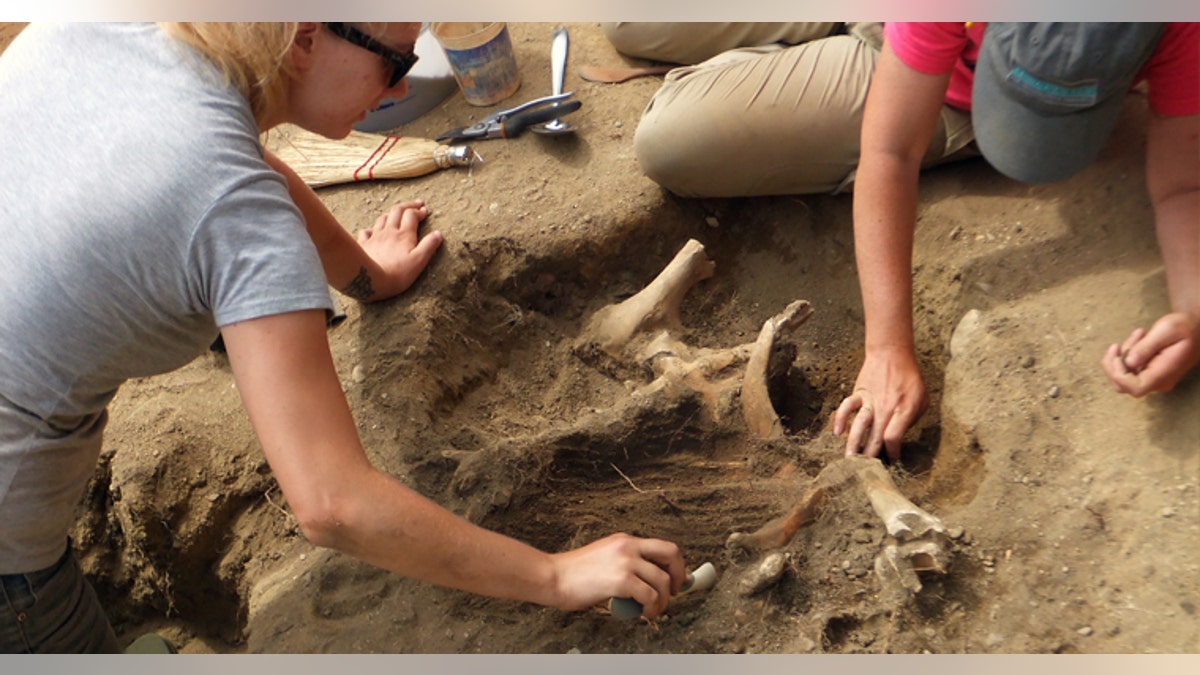
The archaeological dig in Plymouth, Mass. (UMass Boston)
Almost 400 years after the Pilgrims celebrated their first Thanksgiving, archaeologists have unearthed evidence of the original 1620 settlement in Plymouth, Mass.
Researchers from UMass Boston’s Andrew Fiske Memorial Center for Archaeological Research made the find on Burial Hill in Plymouth. Burial Hill includes a cemetery that was thought to be part of the original settlement, according to the Boston Globe, although the site had never been dug by archaeologists before.
The discovery was announced this week, some 395 years after the first Thanksgiving in 1621.
NATIVE AMERICANS CULTIVATED WILD TURKEYS LONG BEFORE FIRST THANKSGIVING
A team led by Fiske Center Associate Director David Landon were thrilled to discover 17th-century artifacts such as pottery, tins, trade beads and musket balls. The artifacts were discovered around so-called “post and ground construction” – holes for wood where structures once stood.
The finds sparked cautious optimism among the team that they had found a location inside the settlement walls. Soon, they discovered the remains of a calf buried in a pit. The calf, dubbed “Constance” by the team, was a vital clue the settlement. Because native people didn’t have domestic cattle her remains prove that she lived and died within the original Plymouth settlement.
“Constance is a great symbol of this. Oftentimes success in the colony depended on herds of cattle. It became a centerpiece of the economy. So the calf does connect us to that story,” said Landon, in a press release.
16TH-CENTURY SHIPWRECKS FOUND AMID ROCKET DEBRIS OFF FLORIDA COAST
Living history museum Plimoth Plantation, which is about 3 miles south of Burial Hill, partnered with UMass Boston on the project.
“Finding physical evidence of the original Pilgrim settlement is an incredibly exciting discovery that can fundamentally change our understanding of the 17th-century Atlantic world,” explained Kathryn Ness, Plimoth Plantation’s curator of collections, in an email to FoxNews.com. “The UMass Boston team’s discovery as a whole proves that, despite 400 years of development, Plymouth Colony is still here and ready to tell us more about the everyday life of the Pilgrims.”
The discovery will prove extremely valuable in Plimoth Plantation’s work, according to Ness. “At our living history museum, these and future findings will help us further refine our exhibits, as we use archaeological evidence and historical documents as the basis for our portrayal of the past,” she said.
EXPLORERS FIND 2ND-OLDEST CONFIRMED SHIPWRECK IN GREAT LAKES
Landon’s team have been working to find evidence of the original settlement prior to the 400th anniversary of the founding of the Plymouth Colony in 2020. The researchers’ discovery came during the first year of a three-year $200,000 National Endowment of the Humanities grant to study the Plymouth Colony and the colonists’ relations with the indigenous Wampanoag people.
More research will be conducted on the Burial Hill site next summer by Landon and his team.
“We are excited to see what else they find!” Ness told FoxNews.com.
Other experts have also been shedding new light on America’s pre-colonial history. Researchers at Florida State University, for example, have uncovered evidence that wild turkeys were a common part of Native American life long before the first Thanksgiving. Native Americans were managing and raising turkeys as early as 1200 – 1400 A.D., they explained, in a paper published Monday in the Journal of Archaeological Science: Reports.
Follow James Rogers on Twitter @jamesjrogers
